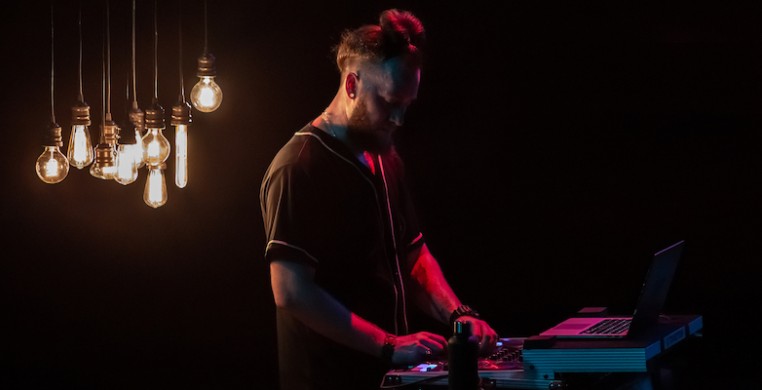Hoofer Nico Rubio and I have some things in common. We both grew up near Chicago in the ‘90s. We both took tap dance lessons as kids—we probably have a few teachers in common. But while I nursed dual interests in ballet and classical music, Rubio was getting immersed in hip-hop culture alongside his tap training.
As the culminating event of his year as a Chicago Dancemakers Forum Lab Artist grantee, Rubio’s full-length show, “By Way of Taps: A J Dilla Tribute” was his way of honoring how hip-hop and tap coalesce rhythmically and culturally through a specific lens: the music of the late rapper and producer James Dewitt Yancey (A.K.A. J Dilla).
“By Way of Taps” (BWOT) had a one-night-only engagement Aug. 25 at Thalia Hall.
I’m just gonna go ahead and be honest: I don’t know who J Dilla is. But I’ve long admired the other half of this remarkable mash-up. As an improviser, Rubio, a rhythm tapper who came up through tap masters affiliated with the Chicago Human Rhythm Project and M.A.D.D. Rhythms maximizes his long limbs with slides and skids—his style is one that nearly always appears on the edge of losing control. But his choreography, by contrast, feels pretty disciplined.
And while it’s certainly not new or original for a tap choreographer to draw inspiration from hip-hop, none of that is to say that “BWOT” is understated or quotidian. What I mean is, it's clear that Rubio idolizes his subject, sticking strictly to tracks either rapped, arranged or produced by J Dilla. And rhythmically, his large cast adheres to the script, either following Dilla’s melodic lines with their feet or embellishing them, never overcrowding. When rhythm tappers take the floor as soloists, they take permission to lay a cacophonous flurry of sounds atop the rhythm section, if they want to, like any other jazz musician. But here, each dancer rarely, if ever, claimed a dominant voice over J Dilla's mixes, which ranged from rap, to R&B, to songs that I perceived as classic jazz. Despite this star-studded cast of players, including legends George Patterson III and Martin “Tre” Dumas III, plus familiar M.A.D.D. Rhythms celebrities like Starinah Dixon and Time Brickey, among others, it was clear that this piece isn’t about them—it’s about J Dilla. Controlled from a laptop by Rubio, who alternates between his DJ podium and the tap floor, each track feels like a surprise, as if we’re peeking in on a couple of cool kids riffing in a garage on pieces of plywood.
Well, at least, that’s how it feels for the first half of the show. Members of 333, Rubio’s pick-up tap trio with Sean Kaminski and young Zayvion Rubio (tap, apparently is a Rubio family affair), kick off the evening on a pop-up stage placed in front of Thalia Hall’s ornate proscenium. Given that it was Thalia’s first ever full-length tap dance show, I wondered if these were logistical concessions made, since only the first two rows of folding chairs—and perhaps those standing in the back—could really see the dancers’ feet. With Rubio’s casual vibe on the microphone, saying “mic check, mic check” each time he picked it up, and simple red lights illuminating the chestnut-hued tap floor, “BWOT” felt scrappy at first, but necessarily so.
And then it sort of just ended. The lights went out, Rubio folded his laptop and left, and we sat in the dark for what felt like a long time, but was probably only a minute or two. Then, the main curtain opened to reveal a magnificent scene.
Atop his throne, DJ Rubio, lit by a chandelier of antique-looking Edison bulbs and standing behind a podium adorned with J Dilla LPs, Thalia Hall, at last, had tappers properly grinding magnificent rhythms into its stage (to be clear, they were dancing on a tap floor laid on top of the stage). The history of this place swirled around us as a large contingent of our city’s best tappers made a joyful noise to the sounds of a hip-hop legend, and honestly, all felt right with the world.
I can only hope this isn’t the last time tap will grace Thalia Hall's stage, and that Chicago’s extraordinary and innovative hoofers will continue to permeate music and dance venues who, for whatever reason, still haven’t bothered to present tap—not because tap needs that to legitimize it, but because everyone should witness it. They're that good.

